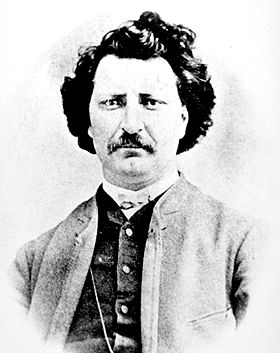The North-West Resistance happened between March 1885 until May 1885. The resistance took place in what is now Alberta and Saskatchewan. It was fought between the Métis and First Nations allies against settlers and the federal government. The government won. Hundreds died. The Indigenous peoples lost everything. The leader of the Métis, Louis Riel, was executed. This caused a serious controversy. It is still a controversial issue. The events of 1885 have left a legacy.
(This article is a plain-language summary of the North-West Resistance. If you are interested in reading about this topic in more depth, please see our full-length entry, North-West Resistance.)
Causes of the Resistance
The Plains Indigenous Peoples and the Métis had a very difficult life on the Prairies decades before the resistance. The bison were gone. So, the Indigenous peoples were starving. Also, they signed treaties with Ottawa. So, they had little land. The Métis also had serious problems. Like the Indigenous peoples, they suffered because the bison were gone. And they were scared that their land would be taken away by new settlers. Many did not think the government was going to help them. The Métis asked Louis Riel to help them. Riel was the leader of the Red River Resistance in 1869–70. He fled Canada in 1870 when he was going to be arrested. (See Red River Resistance (Plain-Language Summary).)

Main events of the Resistance
In the fall of 1884, Louis Riel wrote a “Revolutionary Bill of Rights.” There were 10 Rights altogether. They included the right of Métis to have their own land and farms and the right to have provincial legislatures. Other rights included the right of the Métis to be represented in the legislatures, and for Métis customs to be respected. After this the Métis created a provisional government at Batoche on March 18. Batoche was a small town in what is now Saskatchewan. Riel had set up a provisional government at Red River in 1870. Riel was the president of the provisional government at Batoche.
Soon after, a battle took place at Duck Lake. The Métis and their First Nations allies fought against the North-West Mounted Police. The NWMP lost. In response, Ottawa created an army and sent 5,000 soldiers to the Northwest. At the same time, some Cree and Assiniboine people went to Fort Battleford. On March 30, two settlers were killed. On April 2, a small group of Cree killed 9 men, including Indian agent Thomas Quinn and two priests. Chief Mistahimaskwa (Big Bear) had tried to stop the violence.
The rebels/resistance fighters fought and lost two major battles with the soldiers sent by Ottawa. The first battle was fought at Fish Creek on 24 April. The Métis won. The second battle took place at Batoche between May 9 and 12. The federal troops won. After Batoche, there was very little resistance. The victory of the troops had ended the North-West Resistance.
Prosecutions and Legacy
After the resistance, a series of trials took place. Many Métis and First Nations leaders were charged with treason. Most were sent to prison. Some were executed, including Louis Riel. Many in English Canada thought he was a traitor and should be hanged. The Métis thought he was a hero. Riel’s execution was extremely controversial. The Métis and many people in French Canada were extremely angry.
The hanging of Riel contributed to the struggles between English and French Canada for many years to come. The defeat in the North-West Resistance contributed to the further deterioration of the Métis and Indigenous communities for many years to come as well. Thus, it was an important event in the history of Canada.

 Share on Facebook
Share on Facebook Share on X
Share on X Share by Email
Share by Email Share on Google Classroom
Share on Google Classroom



